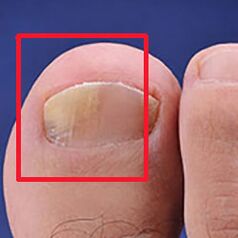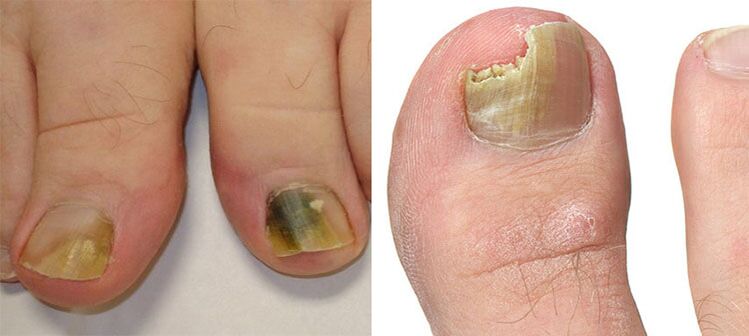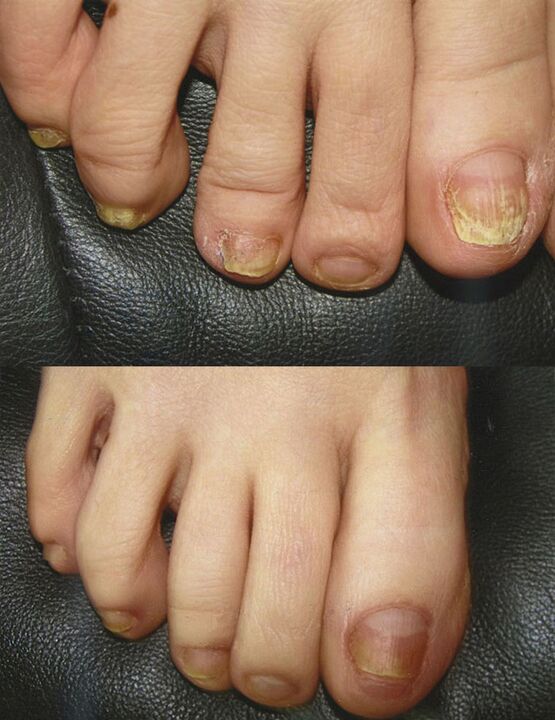The fungus on the legs, called additionally mycosis, is a widespread type of infectious disease. The pathological condition of the feet is not always associated with non -compliance with hygiene: a fungal infection can be easily picked up in public places. It can touch the heels, nails, feet, fingers, skin. At the same time, a person is characterized by sensations of pain, discomfort, disgusting smell.

Powerful mushrooms can only be infected from a person, in turn, becoming a source of infection. The closest environment of the patient immediately falls into the risk group.
Active propagation of fungi is facilitated by a neutral or weak alkaline environment. For example, with abundant sweating, a chance is a chance to "spread" mushrooms on closed skin of the legs. The fungus is not afraid of low temperatures: it is quite stable. After its freezing, the ability to remain the pathogen is not lost. The effect of high temperature (above 70 degrees) destroys the fungus within an hour. In boiling water, the fungus "comes to the end" after three minutes. This distinctive feature can be used by disinfecting personal hygiene, clothing, linen, which was contacted with fungal colonies. Personal household items are subject to boiling and ironing with an iron. The shoes are cleansed with special solutions, for example, one percent formalin. The fungus will not live and 20 minutes after processing.
Every tenth resident of the Earth had to face a fungus. Often, men are a carrier and a distributor of fungal infection. They wear closed shoes for a long time. Women from this disease suffer less.
The causes of a fungal infection on the legs
As mentioned above, fungi "love" the wet environment. They are rapidly propagated in a favorable environment for them:
- in wet shoes;
- sauna;
- pool;
- gym;
- shower;
- In manicure, pedicure salons through tools and accessories.
In those places where humidity is always present. The dried state of things and objects will only temporarily delay the reproduction of fungi. It is worth getting into the environment that is familiar to life, as the growth process will resume.
Micosis is more often than adults, pathology is practically not observed among children. As the number of years old increases, the pH of the skin changes, the structure of its stratum corneum, the immunity weakens, and the body is subjected to multiple diseases.
The appearance of the fungus also contributes to:
- incorrect, irregular foot care;
- wearing shoes with a "strange leg", from poor -quality material;
- endocrine diseases;
- ostentinal pathologies;
- gastrointestinal diseases;
- impaired blood circulation in the lower extremities;
- Stop deformations;
- stressful situations;
- bad habits;
- repeated antibiotic therapy courses;
- anemia.

Not all patients, noticing the pathological condition of the feet, feeling an unpleasant odor, hurry to the doctor. The process of reproduction of fungi is neglected, respectively, it is worse and more difficult to treat, demanding a patient relation for a long time. It should be remembered that fungal colonies infecting the human body actively poison it with toxins. The situation is aggravated by the presence of open wounds, cuts, ulcers, etc.
Localization places and symptoms of a fungus lesion
The appearance of the fungus on the legs depends on the infection that affects the skin:
- dermatitis;
- candidiasis;
- mycose.
The localization of fungi also has its influence on the process of development of the disease, namely:
Most of the suffering, a person is brought to a person "five" fungal lesions. The feet and heels are covered with rough areas of the skin, scars, cracks. The infection is "passing": from one leg to another. At the site of significant redness of the foot, peeling begins, wounds appear with further formation of a thickened crust. The patient experiences painful itching, it hurts him to walk, the leg swells to the ankle. Urgent treatment for medical help is necessary, since the advanced form of the disease is fraught with rotting of infected skin.

The fungus between the toes, subjects the skin, fingers to the nail with the formation of deep wounds. Small wounds appear, the upper layer of the epidermis occurs. The space between the fingers itchs strongly, "burns", exudes bad smells. In case of untimely contacting doctors, serious dermatological diseases may occur, difficult to treat, in the form:
- psoriasis;
- eczema;
- dermatitis.
The nail plate, affected by a fungal infection, is completely destroyed. The beginning of the pathological process is characterized by the formation of spots under the nails of cyanotic, white, yellow. Over time, the spots increase in size, capturing the entire nail plate. Thickening, deformation and destruction of the nail occur. The newly grown nail is also subjected to fungal damage. Only a long course of treatment will contribute to the restoration of a healthy nail.
The symptomatic picture of the fungal damage to the legs is always clearly expressed in the form of certain locations. Therefore, pathology is easily determined at an early stage.
Folk remedies and methods against the fungus
Since the treatment of the legs fungus takes a long time, recovery processes can accelerate the process of recovery, used together with drug treatment.
You can use any recipe found on the Internet, but before that you should consult a doctor. Below are popular and widely used in practice recipes for preparing disinfectants used at home:
- Antifungal solution of soda. Two liters of boiled water (hot), 150 mg of sea salt, 100 g of baking soda are taken. The solution is prepared from all components thoroughly mixed. The legs in such a solution should be kept for half an hour. After making sure that the steaming process has acted, you can remove rough skin, cut the nails. Then again lower your legs into the bath, holding them there for a quarter of an hour.
- Bath with iodine. Hot water (boiled) is also prepared, a solution of iodine at the calculation of 25 g per liter of water. The iodine is stirred in water, the legs are disinfected for 10 minutes, after which they are dried. You need to wear socks.
- Mask with garlic with iodine solution. Hot boiled water, iodine, a clove of garlic are taken again. First, the garlic is pressed through a special device, the resulting gruel is applied to the place infected with a fungus for 10 minutes, then the legs must be washed with a warm solution of iodine, dried and put on socks.
- A solution of chamomile with celandine. Take plants in 25 and 75 g. Accordingly, boil for a couple of 5 minutes. Strain the liquid. In this solution, soar the legs for 15 minutes. After drying them and put on socks. This healing broth not only kills the fungus, but also serves to rejuvenate the skin of the legs.

I must say that effective products against the fungus are inexpensive drugs located in the house or sold in pharmacies. This greatly facilitates the task of prolonged course use. Excellent means include:
- Parkargana. It contributes to the rapid elimination of mycosis. It is used in the form of baths, compresses and applications to the affected places.
- Propolis tincture. With its help, the development of the infectious process is blocked. It is used as applications and baths per five liters of water 50 ml of tincture. Keep your legs in the solution for at least ten minutes.
- Oils, ointments with propolis. They cope well with severe forms of fungal pathology. The oil is sold in pharmacies, and it can also be prepared at home by mixing in equal parts with any antiseptic oily agent. It is better to use it at night.
- . Boric acid. It will quickly help recovery if it lubricates the space affected by the fungus between the toes.
- Alcohol is ammonia. It is used for compresses for the whole night.
In the kitchen in any house, you can find means of non -traditional medicine successfully used to combat the fungus. To do this, use:
- Vinegar (dining room, apple, wine). The manufacture of ointments, preparation of baths, compresses occur on their basis. Vinegar blocks the developing process of damage to the fungus.
- Food soda. With its help, pastes, baths, powders are prepared.
- Garlic. This is a powerful antibacterial agent that helps cope with the fungus. There are many recipes that take into account different features of the disease and the human body.
- Coffee. It is used for baths in the form of a strong solution. The legs soar in it for 10-15 minutes
- Onions. The gruel prepared from it must be applied to infected areas. You can use Vaseline with open wounds, mixing with onion gruel in the same proportions.
- Chicken egg. For the treatment of the fungus, the egg is immersed in vinegar for 24 hours. In the morning, remove the film, 10 g of cream oil is added to the remaining part of the liquid, everything is mixed. It turns out a "magical" ointment to destroy the fungus.
- Tea mushroom. He copes with the growth of pathogenic bacteria perfectly. Can be used as rubbing and compresses.
Prevention
At the first signs of fungal lesion, you should consult a doctor in order to start treatment.
In order to avoid the disease, you need proper hygienic legs care, providing cleanliness and a healthy surface of the skin. It is necessary to wear clean and high -quality socks and shoes. Do not get involved in visiting public places where you can "pick up" a fungal disease. If you are there, it is necessary to comply with the rules of personal hygiene, using only your things and accessories.
Experts also recommend a regular intake of antioxidants:
- ginseng;
- sea buckthorn oil;
- Essential;
- vitamin E and other vitamin complexes.
It is necessary to protect your legs from injury, to carry out careful care with increased sweating. Shoes inside should be treated with special tools preventing the appearance of humidity.
A guest does not need to wear slippers and other home -made shoes, it is better to grab your own. You also need to beware of trying on shoes, sandals and other shoes for barefoot in stores. Always for these purposes you need to carry clean socks with you.
After any water procedures, you need to wipe your legs dry, paying attention to the spaces between the fingers.
If a suspicion of infection with a fungus occurs, you need to use the local antifungal agent and begin to be treated after visiting the doctor.

















